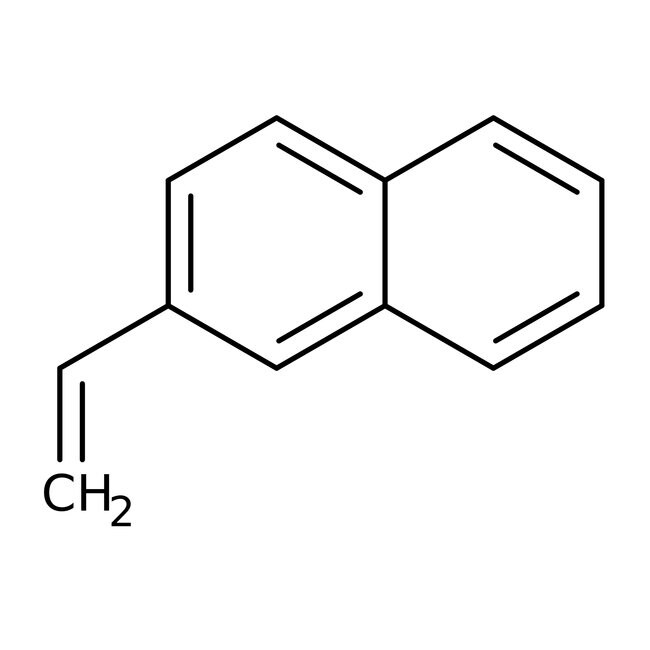Search Thermo Fisher Scientific
Thermo Scientific Chemicals
2-Vinylnaphthalene, 97%, Thermo Scientific Chemicals
Catalog number A12470.14
also known as A12470-14
Price (USD)/ Each
206.65
Online exclusive
229.00 Save 22.35 (10%)
-
Quantity:
25 g
Price (USD)/ Each
206.65
Online exclusive
229.00 Save 22.35 (10%)
2-Vinylnaphthalene, 97%, Thermo Scientific Chemicals
Catalog numberA12470.14
Price (USD)/ Each
206.65
Online exclusive
229.00 Save 22.35 (10%)
-
Chemical Identifiers
CAS827-54-3
IUPAC Name2-ethenylnaphthalene
Molecular FormulaC12H10
InChI KeyKXYAVSFOJVUIHT-UHFFFAOYSA-N
SMILESC=CC1=CC=C2C=CC=CC2=C1
View more
Specifications Specification Sheet
Specification Sheet
Assay (GC)>96.0%
Clarity(0.5% w/v in Acetone): Clear solution
Appearance (Color)White, Cream-yellow to grey-brown
FormPowder
2-Vinylnaphthalene is employed in the synthesis of various copolymers such as Poly (sodium styrenesulfonate-co-2-vinyl-napthalene) copolymer and Poly (2-vinylnapthalene-alt-maleic acid)-graft-polystyrene. The latter finds applications as a photoactive polymer micelle and stabilizer for polystyrene latexes.
This Thermo Scientific Chemicals brand product was originally part of the Alfa Aesar product portfolio. Some documentation and label information may refer to the legacy brand. The original Alfa Aesar product / item code or SKU reference has not changed as a part of the brand transition to Thermo Scientific Chemicals.
Applications
2-Vinylnaphthalene is employed in the synthesis of various copolymers such as Poly (sodium styrenesulfonate-co-2-vinyl-napthalene) copolymer and Poly (2-vinylnapthalene-alt-maleic acid)-graft-polystyrene. The latter finds applications as a photoactive polymer micelle and stabilizer for polystyrene latexes.
Solubility
Soluble in ethanol, acetone, and benzene. Insoluble in water.
Notes
Store under cool dry place. Ensure good ventilation. Incompatible with oxidizing agents. Protect away from heat.
2-Vinylnaphthalene is employed in the synthesis of various copolymers such as Poly (sodium styrenesulfonate-co-2-vinyl-napthalene) copolymer and Poly (2-vinylnapthalene-alt-maleic acid)-graft-polystyrene. The latter finds applications as a photoactive polymer micelle and stabilizer for polystyrene latexes.
Solubility
Soluble in ethanol, acetone, and benzene. Insoluble in water.
Notes
Store under cool dry place. Ensure good ventilation. Incompatible with oxidizing agents. Protect away from heat.
RUO – Research Use Only
General References:
- Curtis W. Frank.; Muhammed Amin Gashgari. Excimer Fluorescence as a Molecular Probe of Polymer Blend Compatibility. 1. Blends of Poly(2-vinylnaphthalene) with Poly(alkyl methacrylates). Macromolecules. 1979, 12 (1),163-165.
- Maria Nowakowska.; Victor P. Foyle.; James E. Guillet. Studies of the antenna effect in polymer molecules. 24. Solar photosynthesis of previtamin D3 in aqueous solutions of poly(sodium styrenesulfonate-co-2-vinylnaphthalene) J. Am. Chem. Soc. 1993, 115 (14),5975-5981.

